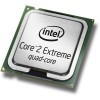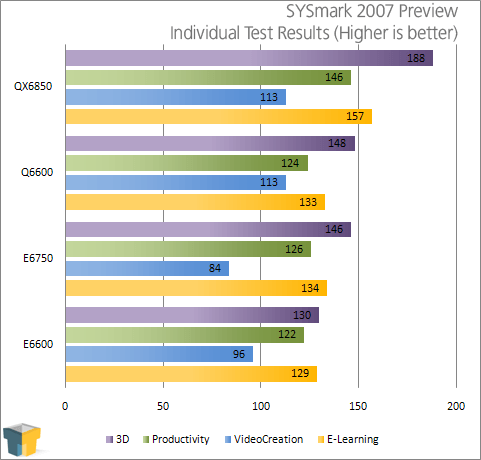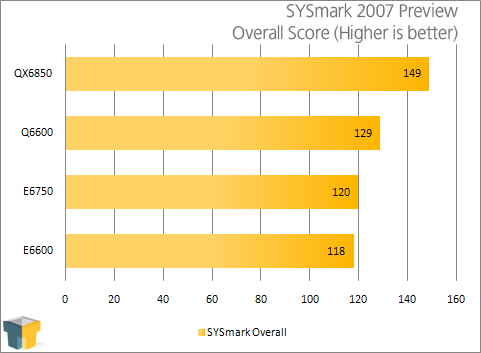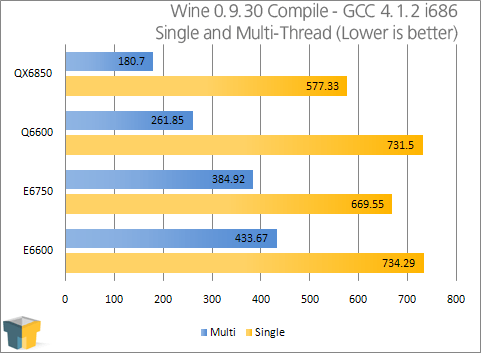- Qualcomm Launches Snapdragon 4 Gen 2 Mobile Platform
- AMD Launches Ryzen PRO 7000 Series Mobile & Desktop Platform
- Intel Launches Sleek Single-Slot Arc Pro A60 Workstation Graphics Card
- NVIDIA Announces Latest Ada Lovelace Additions: GeForce RTX 4060 Ti & RTX 4060
- Maxon Redshift With AMD Radeon GPU Rendering Support Now Available
Intel Core 2 Extreme QX6850 Quad-Core

Intel today is announcing their 1333FSB Core 2 line-up, which consists of three dual-cores, including the E6750 we previewed a few weeks ago, and also the 3.0GHz quad-core that we are testing out today. Read on as we explore all of what Intel’s latest flagship processor has to offer.
Page 3 – SYSmark 2007, GCC Compiler
SYSmark is an industry leading system benchmarking tool, which is completely automated but utilizes real-world tests. It installs common applications such as Microsoft Word and Excel, Photoshop CS2, 3DS Max, SketchUp! among others.
SYSmark grades the performance of the system by how well it could handle different operations. Systems with more than one core will benefit in the tests, since there is a lot of multi-tasking throughout. Once the test is completed, it will provide you with an overall score, in addition to showing areas where the computer excelled.

Running the entire suite shows us that this benchmark is totally capable of handing out appropriate scores for very fast CPUs. There are a few interesting points here. First is the fact that the extra CPU power helped the QX6850 storm past the others in the 3D tests, scoring a full 40 points higher than the 2.4GHz Q6600. It’s important to note that 3D refers to rendering, not gaming.
In addition to that, the three other tests were undoubtedly in the QX6850’s favor. Additional cores are obviously helpful, but the extra frequency in general, can also make a massive difference.

Seeing as how our 3.0GHz chip outperformed everything in all tests, it’s no surprise to see it perform better than our other three CPUs. It scored 20 points higher than our Q6600.
When thinking about faster processors or processors with more cores, multi-media projects immediately come to mind as being the prime suspects for having the greatest benefit. However, anyone who regularly uses Linux knows that a faster processor can greatly improve application compiling, with the GCC compiler. Programmers themselves would see the greatest benefit, especially those who find themselves recompiling their application every few hours.
Even if you don’t use Linux, the results found here can benefit programmers in general, or those who simply wish to know what faster frequencies and additional cores are capable of. GCC is completely multithreaded friendly, so the results found here should represent the average increase you would see with similar multithreaded applications.
For testing, we use Fedora 7 x86, as it’s an easy distro to install and maintain. It’s not bloated, which is important as well. Our target is a copy of Wine 0.9.30. The distro is based on the 2.6.21 Linux kernel and we are using GCC 4.1.2 as our compiler. For single core testing, “time make” was used while dual and quad core compilations used “time make -j 3” and “time make -j 5”, respectively.

My everyday OS is Gentoo, a source-based distro, so to me, these are completely drool-worthy results. By comparison, my 2.5 year old single-core AMD 3200+ Venice, overclocked to 2.7GHz, compiles the same application in 1,985 seconds. Our QX6850 cleaned it up in only three minutes, or just under ten in single-threaded mode. How far we’ve come in only a few years.
Support our efforts! With ad revenue at an all-time low for written websites, we're relying more than ever on reader support to help us continue putting so much effort into this type of content. You can support us by becoming a Patron, or by using our Amazon shopping affiliate links listed through our articles. Thanks for your support!





